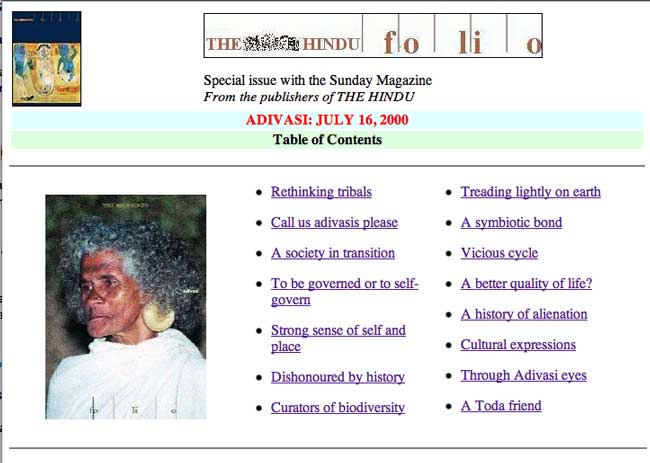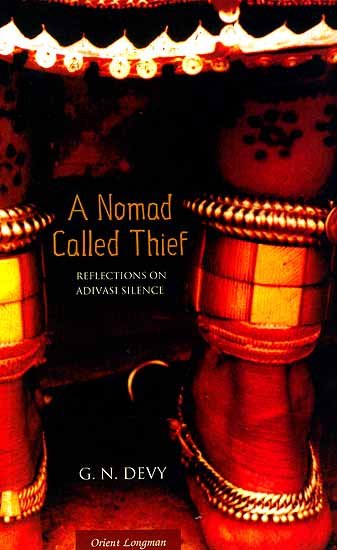References to the region go back to tribal Kurumbars in the 1st century AD – Tamil Nadu
The tribe divided the region into 24 districts and built several forts. Historian Prof K V Raman says, “Places like Mylapore, Triplicane, Egmore, Pallavaram, Velacheri, Thiruvanmiyur and Nungambakkam among many others formed a vital part of the ancient Tondaimandalam.” [a region that made a] significant contribution towards the fields of literature and learning. | More about the Kurumbars’ role in South India’s Paleolithic culture >>

Articles and authors
Rethinking tribals by GN Devy
Call us adivasis, please by Gail Omvedt
A society in transition by Suresh Sharma
To be governed or to self-govern by Smitu Kothari
Strong sense of self and place by Amita Baviskar
Dishonoured by history by Meena Radhakrishna
Curators of biodiversity by KK Chakravarthy
Treading lightly on earth by Ashish Kothari
A symbiotic bond by Mari Thekaekara and Stan Thekaekara
Vicious cycle by Dilip D’Souza
A better quality of life? by Roopa Devadasan and N Devadasan
A history of alienation by Pankaj Sekhsaria
Cultural expressions by Jaya Jaitly
Through Adivasi eyes by Mari Thekaekara and Stan Thekaekara
A Toda friend by S Anandalakshmy
Source: Folio (Special issue with the Sunday Magazine): ADIVASI: JULY 16, 2000 from the publishers of THE HINDU
Date Visited: 15 March 2018 (discontinued since)
Research the above issues with the help of Shodhganga: A reservoir of theses from universities all over India, made available under Open Access >>
Reports in the Indian press | List of periodicals included in this search >>
Search tips
Combine the name of any particular state, language or region with that of any tribal (Adivasi) community.
Add keywords of special interest (music, poetry, dance just as health, sacred grove and biodiversity); learn about the rights of Scheduled Tribes such as the “Forest Rights Act” (FRA); and the United Nations “Declaration on the Rights of Indigenous Peoples”, “Universal Declaration of Human Rights”, “women’s rights”, or “children’s right to education”.
Specify any other issue or news item you want to learn more about (biodiversity, bonded labour and human trafficking, climate change, ecology, economic development, ethnobotany, ethnomedicine, global warming, hunter-gatherers in a particular region or state, prevention of rural poverty, water access).
For official figures include “scheduled tribe ST” along with a union state or region: e.g. “Chhattisgarh ST community”, “Himalayan tribe”, “Scheduled tribe Tamil Nadu census”, “ST Kerala census”, “Particularly Vulnerable Tribal Group Jharkhand”, “PVTG Rajasthan”, “Adivasi ST Kerala”, “Adibasi ST West Bengal” etc.
In case the Google Custom Search window is not displayed here try the following: (1) toggle between “Reader” and regular viewing; (2) in your browser’s Security settings select “Enable JavaScript” | More tips >>
Note: hyperlinks and quotes are meant for fact-checking and information purposes only | Disclaimer >>
Find publications by reputed authors (add “open access” for freely downloadable content)
PDF-repository: texts quoted & further reference (Google Drive) >>

Reflections on Adivasi Silence and Voice by Ganesh [G.N.] Devy | Publications >>
Learn more
Anthropology | Irish Journal of Anthropology | Folio Special issue
Colonial policies | History | Indus Valley | Mohenjo Daro
eBooks, eJournals & reports | eLearning
eBook | Background guide for education
Ekalavya (Eklavya)
Forest Rights Act (FRA) | Hunter-gatherers | Nishad (Nishada, Sanskrit Niṣāda, “tribal, hunter, mountaineer, degraded person outcast”) | Vanavasi (Vanvasi, Vanyajati)
India’s Constitutional obligation to respect their cultural traditions
Jawaharlal Nehru’s “five principles” for the policy to be pursued vis-a-vis the tribals
Particularly vulnerable tribal group (PVTG)
Rabindranath Tagore: a universal voice – Unesco
Remembering Birsa Munda: The charismatic tribal leader who shook the British Empire – Jharkhand
Scheduled Tribes | Classifications in different states
Video | Adivasi Academy & Museum of Adivasi Voice at Tejgadh – Gujarat
Video | Tribes in Transition-III: “Indigenous Cultures in the Digital Era”
What is the Forest Rights Act about?
Who is a forest dweller under this law, and who gets rights?